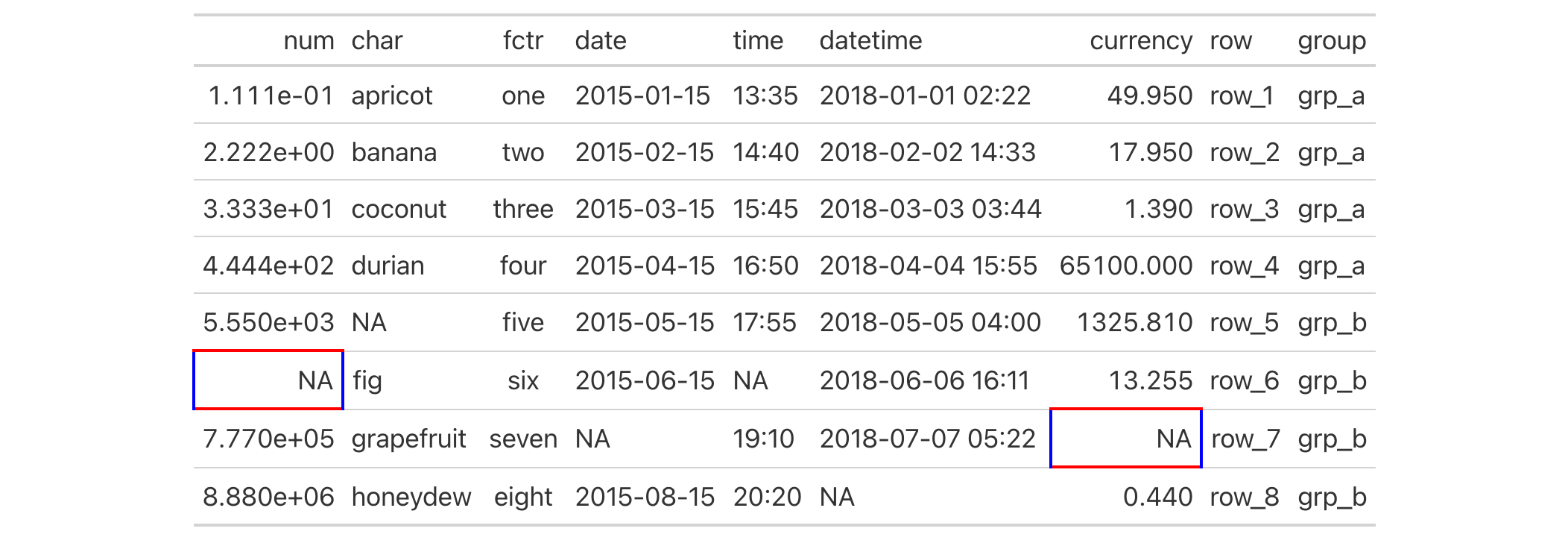cell_borders: Helper for defining custom borders for table cells
In rstudio/gt: Easily Create Presentation-Ready Display Tables
cell_borders R Documentation
Helper for defining custom borders for table cells
Description
cell_borders() is to be used with tab_style(), which itself allows for
the setting of custom styles to one or more cells. Specifically, the call to
cell_borders() should be bound to the styles argument of tab_style().
The sides argument is where we define which borders should be modified
(e.g., "left", "right", etc.). With that selection, the color, style,
and weight of the selected borders can then be modified.
Usage
cell_borders(sides = "all", color = "#000000", style = "solid", weight = px(1))
Arguments
sides
Border sides
vector<character> // default: "all"
The border sides to be modified. Options include "left", "right",
"top", and "bottom". For all borders surrounding the selected cells, we
can use the "all" option.
color
Border color
scalar<character>|NULL // default: "#000000"
The border color can be defined with a color name or with a hexadecimal
color code. The default color value is "#000000" (black). Borders for
any defined sides can be removed by supplying NULL here.
style
Border line style
scalar<character>|NULL // default: "solid"
The border style can be one of either "solid" (the default),
"dashed", "dotted", "hidden", or "double". Borders for any defined
sides can be removed by supplying NULL here.
weight
Border weight
scalar<character>|NULL // default: px(1)
The default value for weight is "1px" and higher values will become
more visually prominent. Borders for any defined sides can be removed by
supplying NULL to any of color, style, or weight.
Value
A list object of class cell_styles.
Examples
We can add horizontal border lines for all table body rows in a gt table
based on the exibble dataset. For this, we need to use tab_style()
(targeting all cells in the table body with cells_body()) in conjunction
with cell_borders() in the style argument. Both top and bottom borders
will be added as "solid" and "red" lines with a line width of 1.5 px.
exibble |>
gt() |>
tab_style(
style = cell_borders(
sides = c("top", "bottom"),
color = "red",
weight = px(1.5),
style = "solid"
),
locations = cells_body()
)

It's possible to incorporate different horizontal and vertical ("left" and
"right") borders at several different locations. This uses multiple
cell_borders() and cells_body() calls within their own respective lists.
exibble |>
gt() |>
tab_style(
style = list(
cell_borders(
sides = c("top", "bottom"),
color = "#FF0000",
weight = px(2)
),
cell_borders(
sides = c("left", "right"),
color = "#0000FF",
weight = px(2)
)
),
locations = list(
cells_body(
columns = num,
rows = is.na(num)
),
cells_body(
columns = currency,
rows = is.na(currency)
)
)
)

Function ID
8-27
Function Introduced
v0.2.0.5 (March 31, 2020)
See Also
Other helper functions:
adjust_luminance(),
cell_fill(),
cell_text(),
currency(),
default_fonts(),
escape_latex(),
from_column(),
google_font(),
gt_latex_dependencies(),
html(),
md(),
nanoplot_options(),
pct(),
px(),
random_id(),
row_group(),
stub(),
system_fonts(),
unit_conversion()
rstudio/gt documentation built on March 29, 2025, 4:02 a.m.
| cell_borders | R Documentation |
Helper for defining custom borders for table cells
Description
cell_borders() is to be used with tab_style(), which itself allows for
the setting of custom styles to one or more cells. Specifically, the call to
cell_borders() should be bound to the styles argument of tab_style().
The sides argument is where we define which borders should be modified
(e.g., "left", "right", etc.). With that selection, the color, style,
and weight of the selected borders can then be modified.
Usage
cell_borders(sides = "all", color = "#000000", style = "solid", weight = px(1))
Arguments
sides |
Border sides
The border sides to be modified. Options include |
color |
Border color
The border |
style |
Border line style
The border |
weight |
Border weight
The default value for |
Value
A list object of class cell_styles.
Examples
We can add horizontal border lines for all table body rows in a gt table
based on the exibble dataset. For this, we need to use tab_style()
(targeting all cells in the table body with cells_body()) in conjunction
with cell_borders() in the style argument. Both top and bottom borders
will be added as "solid" and "red" lines with a line width of 1.5 px.
exibble |>
gt() |>
tab_style(
style = cell_borders(
sides = c("top", "bottom"),
color = "red",
weight = px(1.5),
style = "solid"
),
locations = cells_body()
)

It's possible to incorporate different horizontal and vertical ("left" and
"right") borders at several different locations. This uses multiple
cell_borders() and cells_body() calls within their own respective lists.
exibble |>
gt() |>
tab_style(
style = list(
cell_borders(
sides = c("top", "bottom"),
color = "#FF0000",
weight = px(2)
),
cell_borders(
sides = c("left", "right"),
color = "#0000FF",
weight = px(2)
)
),
locations = list(
cells_body(
columns = num,
rows = is.na(num)
),
cells_body(
columns = currency,
rows = is.na(currency)
)
)
)

Function ID
8-27
Function Introduced
v0.2.0.5 (March 31, 2020)
See Also
Other helper functions:
adjust_luminance(),
cell_fill(),
cell_text(),
currency(),
default_fonts(),
escape_latex(),
from_column(),
google_font(),
gt_latex_dependencies(),
html(),
md(),
nanoplot_options(),
pct(),
px(),
random_id(),
row_group(),
stub(),
system_fonts(),
unit_conversion()
Add the following code to your website.
For more information on customizing the embed code, read Embedding Snippets.
